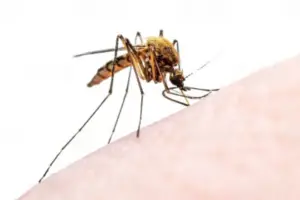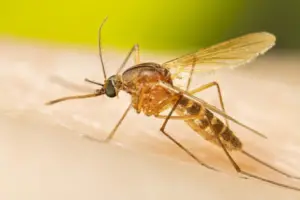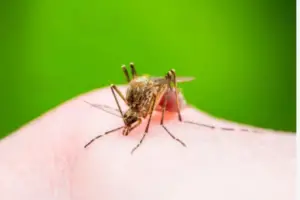Mosquito hawks, often confused with larger mosquitoes or believed to prey on mosquitoes, are actually harmless crane flies.
According to experts like Matthew Bertone and Jon Gelhaus, adult crane flies lack the necessary mouthparts for predation and do not feed on blood or pose a threat to humans. Reports of crane flies biting or stinging are unfounded.
Adult crane flies have limited diets, occasionally consuming liquids like dew or honey water, but this behavior is not commonly observed.
Their main focus is mating, as they have short lifespans lasting only a few days. During their larval stage, crane flies inhabit aquatic environments such as streams, ponds, and damp logs. They emerge as adults, engage in a brief mating period, and then pass away.
True crane flies, belonging to the Tipulidae family, share some physical similarities with mosquitoes, such as narrow bodies, long wings, and stilt-like legs.
However, they exhibit a wide range of wing patterns, colors, and sizes, setting them apart from mosquitoes.
Understanding the truth about crane flies dispels misconceptions and promotes accurate knowledge about their harmless nature and ecological role.
In this guide, you will learn the following: How to recognize mosquito hawks, whether they are harmful or poisonous, what they eat, and how to remove them from your surroundings.
What Is A Mosquito Hawk?
A mosquito hawk is an incorrect label, a case of mistaken identity. Their true name is a crane fly, belonging to the Diptera order and Tipulidae family.
Despite their intimidating name, Crane Flies do not pose a threat to humans and are not predators of mosquitoes.
Throughout time, a sort of urban myth has emerged, suggesting that they consume mosquitoes.
Regrettably for the troubled homeowner, this notion couldn’t be further from reality.
Crane flies (let’s utilize their accurate name) don’t consume much once they reach maturity. It is their larvae that engage in most of the feeding.
What Other Names Are Mosquito Hawk Referred To As?
Crane flies are commonly referred to by various names, including mosquito hawks, mosquito eaters, skeeter eaters, gallinippers, golly whoppers, and daddy longlegs.
Of course, they are not spiders, but due to their remarkably long legs, they are occasionally mistaken for one.
The scientific nomenclature for crane flies differs. Common crane flies are known as Tipula oleracea, while the European crane fly is designated as Tipula paludosa.
The larvae of crane flies are typically called leatherjackets or leather jackets (either spelling is accurate).
Related Post: Green Mosquito: Exploring The Eco-Friendly Buzz
How to Get Rid of Crane Flies, Also Known as Mosquito Hawks
Crane Flies have a tendency to gather around porches and patios due to their attraction to light.
Luckily, they typically have only one reproductive cycle per year, rendering them more of a temporary annoyance than an ongoing threat.
Their presence is usually more prominent during the early Spring or late Fall seasons.
The most effective approach to “removing” them is often to wait until their population naturally diminishes, which typically takes a few weeks.
Considering that Crane Flies, like mosquitoes, rely on water or damp environments for their life cycle, encountering an issue with these insects may indicate a vulnerability to mosquito infestations as well.
Alternative Names for Mosquito Hawk?
Crane flies are known by various names, such as
- mosquito hawks
- mosquito eaters
- skeeter eaters
- gallinippers
- golly whoppers
- daddy longlegs.
These creatures, despite being mistaken for spiders due to their remarkably elongated legs, do not belong to the spider family.
The scientific name for crane flies
The common crane fly is referred to as Tipula oleracea, while the European crane fly is named Tipula paludosa.
The larvae of crane flies are commonly called leatherjackets or leather jackets, with both spellings being accurate.
Other Insects The Mosquito Hawks Are Commonly Confused With
Crane flies, popularly referred to as mosquito hawks, often get mistaken for other insects, as evident from the various common names associated with them.
Let’s take a quick look at some of these misconceptions.
mosquito eater Vs. Mosquitoes
Some individuals mistakenly believe that mosquito eater are oversized mosquitoes.
Observing mosquito eater in flight, they assume that mosquitoes are appearing larger and earlier in the year.
Once again, these urban legends are entirely untrue.
Mosquitoes are relentless hunters that seek out mammals for feeding, while crane flies are among the most gentle insects in the world.
Many species of adult crane flies lack mouthparts altogether since they do not live long enough to experience hunger.
Crane flies are significantly larger than mosquitoes, and their wings lack the microscopic scales present on mosquitoes.
Female mosquitoes are bloodsuckers, whereas adult crane flies solely exist to mate, lay eggs, and subsequently perish
Mosquito Howks Vs. Dragonflies
Due to their similar appearance, crane flies are frequently confused with dragonflies.
This confusion arises because dragonflies feed on mosquitoes, leading people to wrongly associate this behavior with crane flies.
Consequently, they are sometimes referred to as mosquito hawks or mosquito eaters.
Crane flies have long, detachable legs and are mostly brown or tan, while dragonflies exhibit vibrant, almost iridescent colors.
Although their body shapes are quite alike, their colors serve as the primary visual differentiator.
Dragonflies are aggressive hunters, whereas adult crane flies primarily feed on nectar, or in some cases, they may not eat anything at all.
Once they reach maturity, certain species of crane flies cease to consume any form of sustenance. Since their lifespan is only a few days, their feeding habits are not a necessity.
Mosquito Hawk Vs. Daddy Longlegs
Another mistaken identity for crane flies is daddy longlegs, daddy long legs, or daddy-longlegs (various spellings are acceptable).
This misconception has led to the belief that crane flies are venomous, similar to how daddy longlegs are commonly perceived.
However, both of these notions are incorrect.
In reality, daddy longlegs are not spiders; they belong to a different species known as Opiliones.
Despite their resemblance to spiders due to their eight legs, they lack two defining characteristics of spiders: venom and silk production.
Daddy longlegs do not possess either of these traits.
There is an urban legend suggesting that daddy longlegs are highly poisonous but unable to penetrate human skin due to their weak fangs.
This, too, is false. Daddy longlegs possess mouthparts similar to those of crabs and scorpions, which they use to grip their prey while feeding.
Daddy longlegs are not spiders, do not produce venom, and do not bite humans—ever.
Consequently, any narrative associating crane flies with daddy longlegs is equally incorrect. Similar appearance does not equate to similarity in species.
What Does A Mosquito Hawk Eat?
Crane flies, also known as “mosquito hawks” or “skeeter eaters,” are harmless insects that rely on plant nectar for sustenance.
As adults, they focus on reproduction and egg deposition rather than feeding. In contrast, crane fly larvae consume various plant materials such as grass roots, decaying wood, and algae.
Adult crane flies have a short lifespan of about 10 to 15 days, during which they primarily seek mates and lay eggs.
They rarely engage in feeding, but when they do, it is mainly nectar and pollen.
Unlike their larval stage, adult crane flies do not pose a threat as they lack the ability to suck blood or damage crops and vegetation.
How to Control Crane Flies (Mosquito Hawks) Effectively:
- Use Reclaim I/T insecticide between August and February to control crane flies. Applying it outside this period will only suppress their presence instead of effectively controlling them.
Step 1 – Application of Bifen LP Granules on Your Lawn:
- Calculate the square footage of your lawn and apply Bifen LP granules at a rate of 4.6 pounds per 1,000 square feet to control mosquito hawk larvae. Use a push broadcast spreader or a hand spreader for smaller areas. Spread the granules evenly across your lawn.
Step 2 – Measurement and Mixing of Reclaim I/T and Martin’s I.G. Regulator:
- Mix Reclaim I/T and Martin’s IG Regulator to create a solution that controls mosquito hawks and disrupts their life cycle. The recommended rates are 0.75 ounces of Reclaim I/T and 1 ounce of Martin’s IG Regulator per 1,500 square feet. Use a 20-gallon hose-end sprayer to apply the solution.
Step 3 – Application of the Mixed Solution:
- Attach the sprayer to the hose and evenly distribute the mixed solution across your lawn. Apply the solution using a fan-tip spray setting, starting from the back and moving towards the front. Choose calm days with low wind speeds for minimal drift.
Prevention of Mosquito Hawks:
- After eliminating mosquito hawks, maintain a healthy lawn by mowing at the appropriate height (3 to 4 inches), watering less frequently (1 to 1.5 inches once a week), removing thatch, and ensuring proper soil aeration and drainage. These measures will help prevent future crane fly infestations.
Interesting Facts About Mosquito Hawks
Here are eight facts about these insects you need to know:
Fact 1: Crane flies are often mistaken for Daddy Long Legs, but they are a different species than cellar spiders.
Fact 2: Mosquito eaters primarily feed on flower nectar, occasionally consuming mosquito larvae during their larval stage.
Fact 3: Crane flies are larger than mosquitoes but lack the ability to kill them.
Fact 4: While crane flies do not bite humans, the sound produced by their wings can be annoying.
Fact 5: Two common types of crane flies found in homes and gardens are the European crane fly and the common crane fly, which have similar appearances but differ in their number of life cycles per year.
Fact 6: Crane flies reproduce rapidly, especially in warm weather, often buzzing around outdoor lighting fixtures.
Fact 7: Crane flies are considered pests as they harm plants by feeding on roots and leaves, impeding their growth potential.
Fact 8: A healthy garden attracting other insects, birds, and small wildlife can help control the population of mosquito eaters.
Closing Remarks
Crane flies, often known as mosquito hawks, are typically benign creatures. They neither bite nor sting, and their short lifespan does not categorize them as pests according to the majority of pest control specialists.
We trust that this evaluation by Pest Strategies has provided you with a fresh perspective on these insects and their significance within our environment.
FAQ
1. Can Crane flies consume mosquitoes?
No, Crane flies do not consume mosquitoes. They are harmless creatures, contrary to popular belief, although they are sometimes referred to as “mosquito hawks” or “mosquito eaters.”
2: Do crane flies possess a biting behavior?
No, Crane flies do not possess biting behavior. They are harmless to humans, livestock, and pets. However, if they appear in large numbers, they can pose a significant threat to agricultural crops and golf courses.
3: How can crane flies be distinguished from mosquitoes?
Crane flies have straight bodies, and their wings are spread out when they are at rest, whereas mosquitoes have a hunched appearance with folded wings during rest. Additionally, crane flies are harmless, whereas mosquitoes bite and can transmit diseases.
4: What is the diet of mosquito hawks?
Mosquito hawks, also known as crane flies, primarily feed on nectar and pollen. It is important to note that, contrary to popular belief, they do not consume mosquitoes.
5: Are there any insects resembling giant mosquitoes?
Crane flies are often mistaken for giant mosquitoes due to their long legs and slender bodies. However, they do not bite humans and mainly rely on nectar as a food source.
Feel free to contact our office today to schedule a complimentary evaluation for your Mosquito Reduction requirements and begin enjoying your time in the yard.





